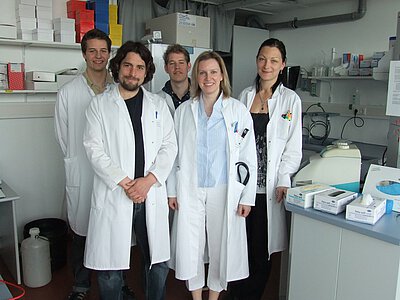Identification of mutated genes in novel forms of HSP
Hereditary spastic paraplegia (HSP belongs to the group of Motor Neuron Disorders (MND). HSP can be divided into pure (or uncomplicated) and complex (or complicated) forms. Pure HSPs are characterized by the presence of isolated pyramidal motor neuron dysfunction. Complex HSPs are characterized by the association of additional neurologic or extraneurologic features. All patterns of inheritances have been observed in HSP.
In collaboration with neurologist from Chile and Turkey, we have recruited two large pedigrees in which several individuals show a clinical picture of spastic paraplegia as the primary and predominant feature. In the Chilean family, a pure HSP was diagnosed with dominant inheritance albeit reduced penetrance. Conversely, in the Turkish family, the clinical evaluation revealed further neurological features and a thin corpus callosum upon brain imaging. We assumed a recessive mode of inheritance in this family, since all individuals available for the analysis resulted from marriages between healthy but consanguineous persons. In both families, we excluded linkage to common HSP loci. Next, we performed an SNP-based whole genome screen resulting in the identification of two new loci. However, both regions were very large containing numerous genes that can be considered attractive candidates.
The present application aims at: (i) detailed clinical investigation of family 1, (ii) identification of the causative mutation in both families, and (iii) definition of the mutational and phenotypic spectra for both of these novel genes. To this end, all patients of the Chilean family will be re-evaluated by movement disorders experts. DNA of additional family members will also be collected during the course of these clinical visits. The identification of causative mutations will base on next generation sequencing approaches of the exons of all genes from the candidate regions. In addition, large heterozygous genomic rearrangements will be analyzed in these families. Once the above investigations will result in the identification of novel HSP genes with high confidence, additional patients and controls will be screened for alterations in these genes.
The results of the proposed project will lead to in the description of two novel forms of HSP and the underlying disease genes. These data will directly translate into routine molecular diagnostics of HSP. Moreover, the identification of novel HSP genes will represent novel ground for functional investigations into the pathological processes underlying the disease. Unraveling the complete spectrum of cellular functions/malfunctions involved in HSP will ultimately be the basis for developing appropriate therapeutic strategies.





